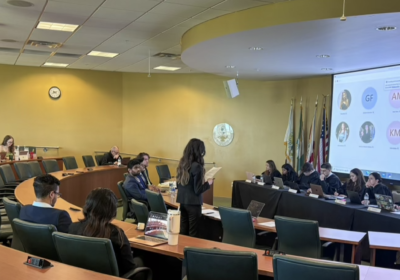Tuition billing lacks ‘transparency’ in student fees

Currently, students taking a 15-credit-hour course load pay roughly $768 per semester in student fees, including $37 in flat rate fees. ORACLE GRAPHIC/ADAM MATHIEU
The biggest complaint among college students is the rising cost of tuition and fees, but if you were to ask students at USF where exactly their tuition money is going, they are not likely to know.
Students who attempt to view their tuition and fees receipts through OASIS are met with a number of charges labeled simply as “Tuition.” These charges are made up of a handful of student fees, including the per-credit-hour charges for Athletic, Health, and Activity and Service fees, all bundled into multiple “Tuition” amounts.
Corey Ulloa is a Student Government (SG) senator, as well as a member of the Local Fees Committee, the committee in charge of deciding which student fees to raise and by how much.
In the year he has been on the committee, Ulloa said he has never seen a student show up to one of the public meetings and believes the way in which student fees are hidden on OASIS may prevent more broad participation from students in issues that directly effect them.
“I think it’s a big part of it because, until last year when I was in SG, I didn’t know that (fluctuating student fees) actually existed either,” Ulloa said. “I just saw the ‘tuition’ charges on my OASIS and just thought ‘OK, I’m paying random fees for tuition.’”
Ulloa said he feels there needs to be more transparency on OASIS to give students some context for raises to student fees.
“In the committee we actually talk a lot about the fees and what they’re at now -—so we have those numbers,” Ulloa said. “I don’t know why they are not necessarily on our OASIS pages for students to see where all their money is going.”
Student fees are used for everything from buying new gym equipment and subsidizing student organizations to covering state-mandated salary increases. The proposed student fee increases for this year will provide funding for projects such as a new gym in the USF Health area and paying scholarship differentials for student-athletes.
SG student body president Jean Cocco said he agrees with Ulloa and campaigned specifically on the issue of transparency in student fees last year.
He said the lack of transparency on OASIS becomes an issue when SG attempts to solicit feedback from students who may not know they are even paying these fees.
“It’s definitely an issue of transparency,” Cocco said. “You look at your fees and you’re like, ‘What the hell is that? Where does this stuff go to?’”
Previously, the only way for students to see exactly how much they were being charged in per-credit-hour student fees was to navigate three separate pages of the Office of the General Counsel’s website, find the specific regulation regarding tuition and fees (USF4.0102), and read through the six-page document.
After an inquiry by The Oracle into the transparency of tuition and fees and the accessibility of tuition information for students, the Controller’s Office placed a link to the tuition and fees regulation on its website, according to Assistant Vice President and Controller Jennifer Condon.
The link went live on the Controller’s Office website Thursday, Condon said.
Before Thursday, the Tuition and Fees page of the Controller’s Office website only offered information on the flat rate student fees that students can access through OASIS.
On top of the $37 flat rate fees students pay every semester, students are currently charged $48.74 per credit hour for seven fees that fluctuate each year.
The Local Fee Committee approved a $1.82 overall increase to the Activity and Service, Health and Athletic fees.
Beginning next academic year, a student taking a 15 credit-hour course load can expect to pay roughly $195 per semester for the Activity and Service fee, $227 per semester for the Athletic fee and $168 per semester for the Health fee.
The reason for clumping together fees and charges on OASIS, Condon said, is because the university feels students would be overloaded if they could see the specific fee charges on their OASIS accounts each semester.
“We’re happy to provide the information, we just don’t want to overload other folks with information they don’t want,” she said.
Condon also said the university believes most students don’t want to see the exact fees they pay for through OASIS, based on feedback the Controller’s Office has received.
Condon said the ideal situation would be to implement some sort of drop down on the Account Summary page that would allow students who want it to see a more detailed receipt of tuition and fee charges, but said she’s been told that’s not possible with the way the university has designed the OASIS system.
“You’re talking about a system that’s been implemented long before you and I even dreamed of being at USF,” Condon said. “So I think it’s the way that it’s implemented, we’re kind of down this road with the way we enter our fee rolls.”
However, the Controller’s Office is currently working to introduce new memo functionality in OASIS, but only for students who have Florida Prepaid.
At present, students with Florida Prepaid can’t see some tuition and fee charges after they are paid by the Florida Prepaid College Program.
“The charges go onto your account and come off the account and then they’re just gone,” Condon said. “That’s not the most transparent thing and that’s the way the system has always worked.”
Condon said the university is close to implementing the system soon, but has run into issues with the Florida Prepaid billing system. She said the university has had to double back and find a new tactic to make the changes available.
The changes to the OASIS account summary for Florida Prepaid students would not affect the detail of the tuition and fee charges.
Despite the Controller’s Office currently having no plans to offer a more-detailed summary of payment to students, some administrators, along with SG representatives, hope to be able to work out a more accessible system of billing.
“The Office of Student Success is prepared to work with all parties to streamline all of our billing processes,” said Paul Dosal, vice provost for Student Success. “To the extent that we can develop a billing process that is easier to understand and manage, I’m in favor of working on it with all stakeholders.”






